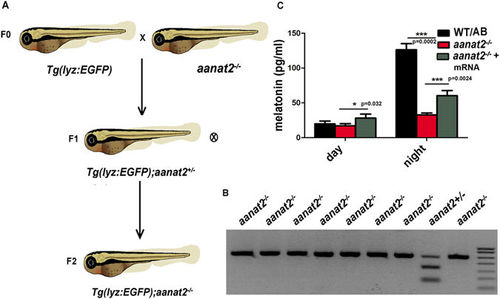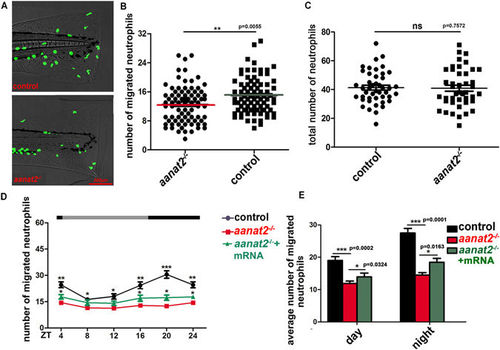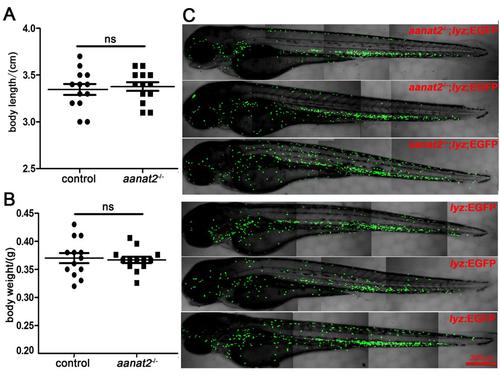- Title
-
Endogenous melatonin promotes rhythmic recruitment of neutrophils toward an injury in zebrafish
- Authors
- Ren, D.L., Ji, C., Wang, X.B., Wang, H., Hu, B.
- Source
- Full text @ Sci. Rep.
|
Establishment of a visual model for monitoring neutrophil migration in aanat2 −/− zebrafish. (A) Hybridization of transgenic line Tg(lyz:EGFP) labeling neutrophils and aanat2 mutants for two consecutive generations. (B) In F2 zebrafish, we identified the homozygous aanat2 −/− transgenic zebrafish. Extracted genomic DNA from the tail fin of screened transgenic zebrafish was amplified using PCR and digested using the MspI enzyme. The uncleaved band indicated homozygous zebrafish. (C) To evaluate the functional effect of Tg(lyz:EGFP);aanat2 −/− zebrafish, we measured melatonin levels using an ELISA. Fifty larvae were homogenated and then melatonin was extracted using methanol as an individual sample (IBL international, Germany). The experiment used three samples. Results indicated that melatonin was significantly decreased at night compared with WT/AB larvae. The melatonin content could be partly rescued by injection of aanat2 capped mRNA (control, n = 50; mutant, n = 50; mutant + mRNA, n = 50) (ANOVA analysis). (***P < 0.001). PHENOTYPE:
|
|
Neutrophil recruitment was significantly reduced in aanat2 −/− larvae. (A,B) Using a tail fin injury model in Tg(lyz:EGFP);aanat2 −/− zebrafish (4 days), we evaluated the effects of an aanat2 mutant on neutrophil migration at 12:00 in the day. Results showed that aanat2 mutants had significantly decreased neutrophil recruitment (control, n = 90; mutant, n = 90). Neutrophils located at 250 μm from the wound ending were counted and regarded as the valid migration number. The experiment was repeated three times (unpaired t-test analysis). (C) The total number of circulating neutrophils was analyzed by counting fluorescent particles within the 800-μm region from the spinal cord end to the anterior at 12:00. There had no significant difference between the WT/AB (n = 60) and aanat2 mutant groups (n = 60). The experiment was repeated three times (unpaired t-test analysis). Each experiment contains 60 samples. (D) To evaluate the rhythmic migration of neutrophils in aanat2 −/− zebrafish under LD condition, we monitored neutrophil migration at 4-h intervals in a day-night period using a fluorescent microscope. The results showed that rhythmic recruitment of neutrophils was abolished in aanat2 −/− larvae and the migrating neutrophils could be partly rescued by injection of aanat2 capped mRNA (control, n = 30; mutant, n = 30; mutant + mRNA, n = 30). The data was repeated with three independent experiments (ANOVA analysis). Each experiment contains 30 samples. (E) The average number of migrating neutrophils at both day and night was lower in aanat2 −/− compared with wild types (control, n = 90; mutant, n = 90). The data was analyzed from Fig. 3D. ZT: zeitgeber times. (**P < 0.01, ***P < 0.001). PHENOTYPE:
|

ZFIN is incorporating published figure images and captions as part of an ongoing project. Figures from some publications have not yet been curated, or are not available for display because of copyright restrictions. |

ZFIN is incorporating published figure images and captions as part of an ongoing project. Figures from some publications have not yet been curated, or are not available for display because of copyright restrictions. |
|
No significant changes of body length, body weight and neutrophil distribution in aanat2 mutant zebrafish. (A, B) Body length and body weight of adult zebrafish (4 months years old) were not significantly different between the wild type and aanat2 mutant groups (n=13, unpaired Student’s t-test). (C) Confocal imaging of the whole larvae (4 days post fertilization) showed that the aanat2 mutation did not cause a change in the visualized neutrophil distribution and number. |



